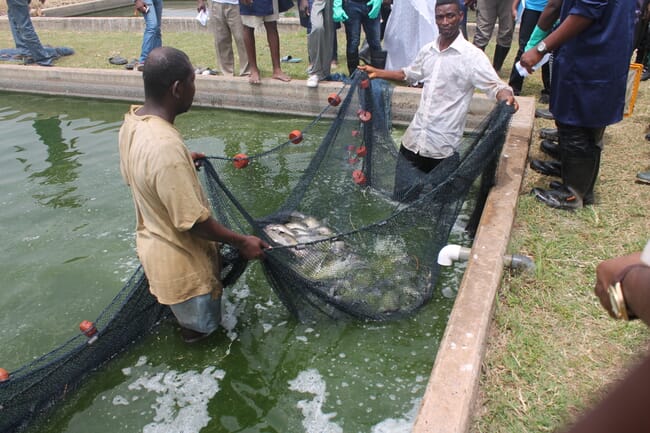However, there is still a long way to go before aquaculture can hope to close the huge gap between the country’s seafood demand (1 million tonnes per year) and supply (440,000 tonnes).
The recent opening of an Aller Aqua office in Accra, the Ghanaian capital, can be seen as a positive indication of the prospects for the country’s aquaculture industry, although Israel-based Raanan Feeds is currently the only commercial extruded feed producer, supplying 70% of its 30,000 tonne annual production to the local market, and exporting the balance to neighbouring countries.
Popular international feed brands are easily available. But small scale fish farmers complain that commercial feeds absorb at least 60% of their production budget. Experts attribute the apparent unaffordability of commercial feed to competing demands for maize, and the sharp devaluations of the local currency which have affected the cost of soya meal. An official of Raanan told The Fish Site that the high cost and demand for maize and soya meal makes locally produced commercial feed almost as expensive as imported.
Although there are many small-scale pond farmers all over Ghana, they account for less than 25% of the country’s annual production. A small number of foreign cage farmers account for the bulk of production. Tilapia, the preferred choice of an increasing number of Ghanaians, constitutes 80% of production, with catfish accounting for 20%. Whilst locally produced and imported feeds are easily available on the market, most small pond farmers find them expensive, and try to avoid this problem by using self-formulated feeds.

Maize, the main carbohydrate source for poultry and fish feed, is also the prime cereal consumed by humans in Ghana, and this high demand drives up the price. Soya meal is mainly imported from the US, and the continuous decline of the national currency over the last couple of years has driven prices upwards. Researchers have identified quite a number of agricultural by-products as viable alternatives to maize. These include cocoa pod husk, palm kernel cake and wheat bran and these are regularly used by most pond farmers.
Recent research has focused on black soldier fly (BSF) larvae as a viable protein source in fish feed. Several universities and research institutions have reported positive finding on the deployment BSF in fish and other livestock feeds. Successful trials by the University of Stirling in collaboration with Raanan Foods and the Animal Research Institute under the EU funded Proteinsect Project has shown that BSF provides a 50% replacement for feed without affecting fish performance. Enterprise Ghana, funded by the Department for International Development of the UK, is also popularizing the use of insects grown on organic waste as fish feed. What is needed now is the deployment of tested feed sources in commercial production.
The Aquaculture Research and Development Research Commission recently reported results of tests carried out to evaluate two commercially produced diets and two made onsite by farmers from six commonly used ingredients. They found that “nutritionally balanced farm-made fish diet is cost effective and will boost growth of aquaculture in rural areas where semi-intensive pond aquaculture is mainly practiced in Ghana”. Whilst this could prove useful to some small and medium pond farmers, many lack the skills and information to produce hygienic and nutritionally balanced feeds on their farms.
At an international conference on ‘Agro By-products in Animal Feed Production in West Africa’ in Kumasi, Ghana, Professor Oyedapo Fagbenro, one of Africa’s major aquaculture experts, emphasized the need to reduce the cost of fish feed by deploying the continent’s local crops and by-product resources, which are presently being underutilized or wasted. In order to maximize their efficiency, however, he advised that “due attention should be focused on dealing with endogenous toxins and anti-nutritional factors”.
The challenge for regulators of the aquaculture industry is to ensure that high quality feed is available to all fish farmers at affordable cost. Jacques Magnee, Commercial Director of Raanan Feeds, believes that Ghana abounds in viable sources of fish feed ingredients which can make a great difference in national aquaculture output. The crucial question, he says, is whether they can be supplied in commercial quantities on a continuous basis.
“At Raanan, we would be delighted to source raw materials locally, because imported inputs are expensive,” he explains.
He hopes that the relevant agencies will provide the required support to make this happen in the near future. Until this is done, he said, Ghana will have to continue to pay premium prices for commercial feed.


